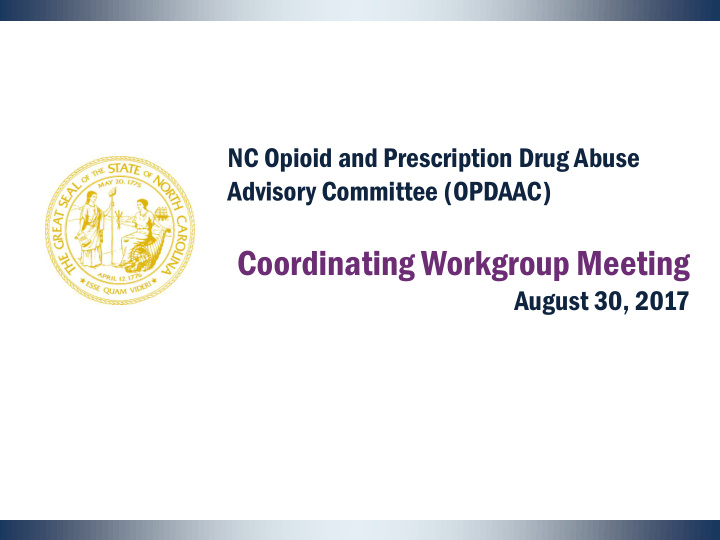



NC Opioid and Prescription Drug Abuse Advisory Committee (OPDAAC) Coordinating Workgroup Meeting August 30, 2017
Welcome! and Introductions of Attendees • Welcome! − Mandy Cohen − Josh Stein • Introductions of Attendees − Your name − Your organization/affiliation
Susan Kansagra and Steve Mange Purpose and Meeting Goals
Alan Dellapenna Forming and Norming
Forming and Norming: Relation to OPDAAC
Forming and Norming: Expectations • What are our group expectations pectations of this workgroup? − Coordinates implementation of NC Opioid Action Plan −Select membership leads NC’s effort to prevent and respond to NC’s opioid crisis and tracks progress − Respects and appreciates different perspectives − Title free zone − Opportunity for candid, thoughtful, focused discussions of real issues and root causes without defensiveness − Meets need for collective wisdom to address complex issues − Action oriented learning to identify new solutions − Meets 8 times a year (any non-OPDAAC month)
Forming and Norming: Expectations • What are our group expectations pectations of this workgroup? − ???
Forming and Norming: Leadership • What leade dership hip role will Coordinating Workgroup members take in coordinating, implementing, and tracking the NC Opioid Action Plan? − ???
Anna Stein NC Opioid Action Plan
Nidhi Sachdeva Problem Analysis
Problem Solving: Approach • Process based on Action Learning Powerful model for change questions • Facilitated discussion allows for maximum Active learning ACTION Listening • Opportunity to come up with different, workable, useful, and timely solutions Sharing and Reflection learning
Problem Analysis: Method 1. 1. PROBLEM LEM STATEME MENT NT (>10 minut utes) es) − A pressing/difficult problem or challenge that: • is related to a focus area or strategy included in the NC Opioid Action Plan • is a problem you have been struggling with and has no known or clear solution; • is a problem that you are involved in or that implicates you/your organization; • is a complex problem that requires the coordination or input of multiple organizations or levels of work beyond your immediate scope; • People could have multiple opinions or disagree about the solution to the problem; and, • It is important to you (and/or your organization) to find a solution soon − State e the proble lem m in in the fo form of a questio tion. 2. 2. CLARIFIC IFICATION TION (5 minut utes es) 3. 3. GROU OUP P DISCU CUSS SSION/OBSE ION/OBSERVATIO ION N (20+ minut utes) es) 4. 4. REFLECT CTIO ION/ANAL N/ANALYSI SIS (8 minut utes es) 5. 5. ACTION ON (2 minut utes es)
>10 minutes Problem Statement Jai Kumar and Julia Wacker, NC Hospital Association
Coalition for Model Opioid Practices in Health Systems: Care linkages
CDC Prevention for States (PfS) Grant NC Division of Public Health supports NCHA under CDC PfS Components 1 and 2 15
Area of Concern
NC Opioid Action Plan
NC Opioid Action Plan
Problem Analysis How do we ensure patients are discharged from inpatient units to proper treatment and appropriate care in the community?
5 minutes Phase 2: Clarification
20+ minutes Phase 3: Group Discussion/Observation How do we ensure patients are discharged from inpatient units to proper treatment and appropriate care in the community?
8 minutes Phase 4: Reflection/Analysis
2 minutes Phase 5: ACTION
Next Steps and Wrap-up • Next Full OPDAAC Meetings − September 29 − December 15 • Next Coordinating Meeting, October XX • Homework: Complete Surve vey by 9/6 to − prioritize Top 5 Actions from NC Opioid Action Plan − rank preference on regular meeting days/times − provide other feedback Survey link:
Thank you!
Recommend
More recommend